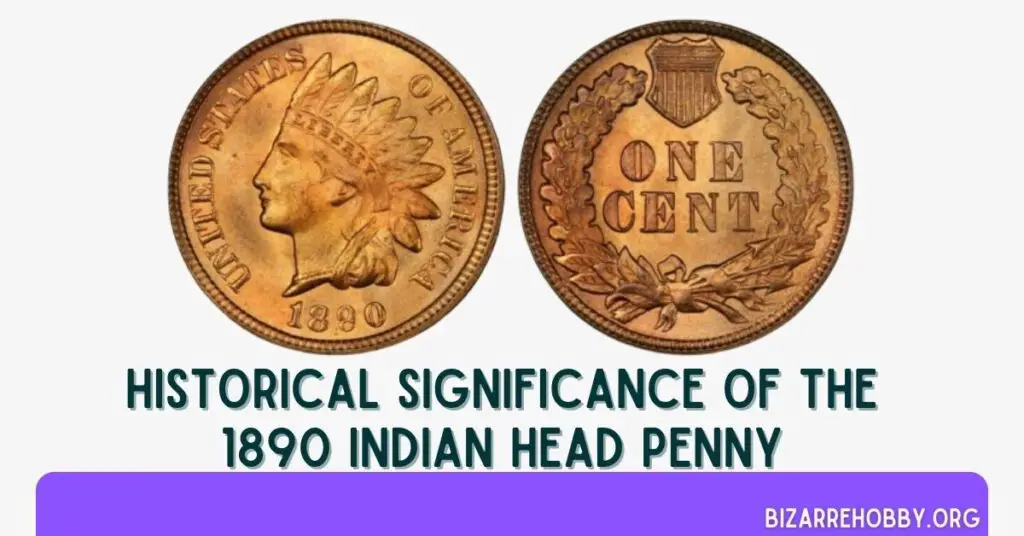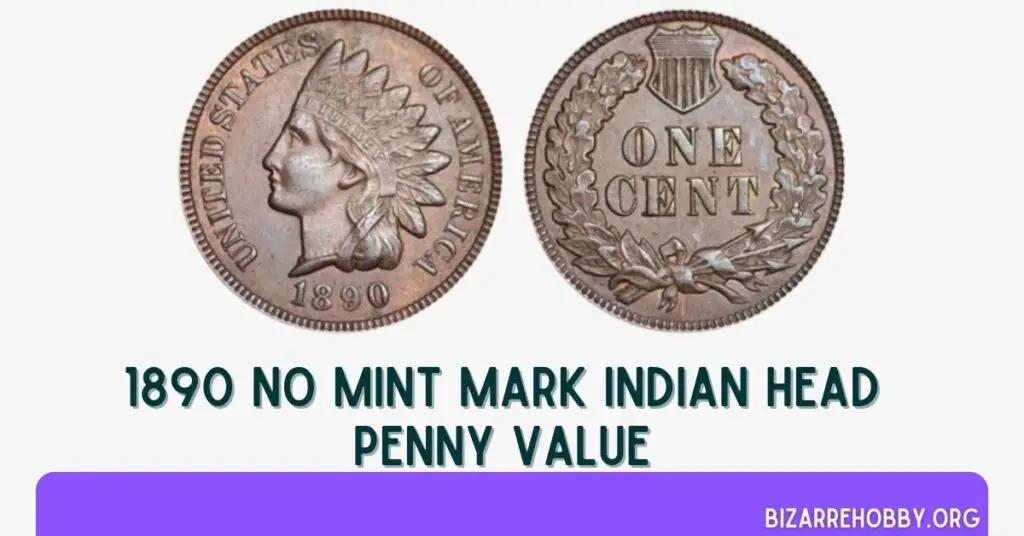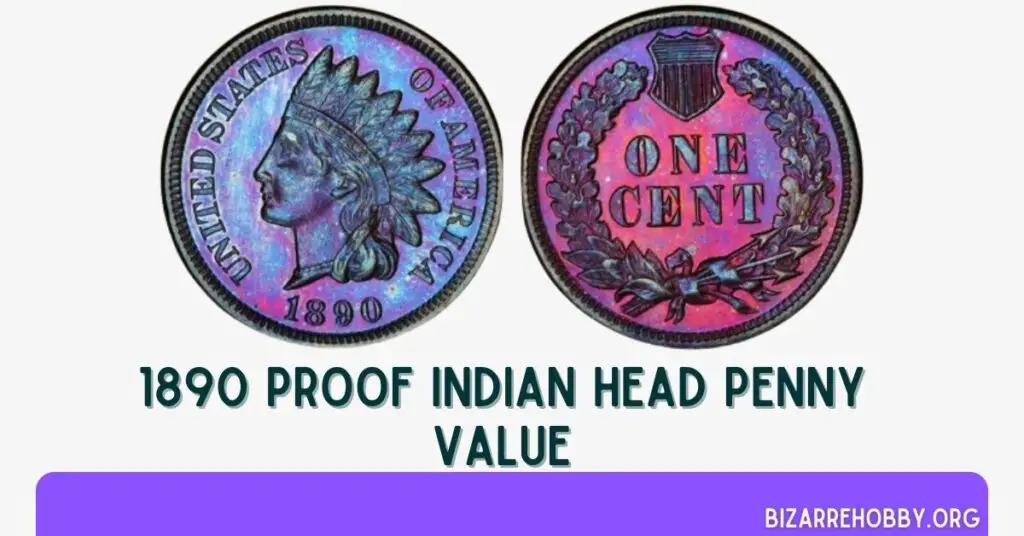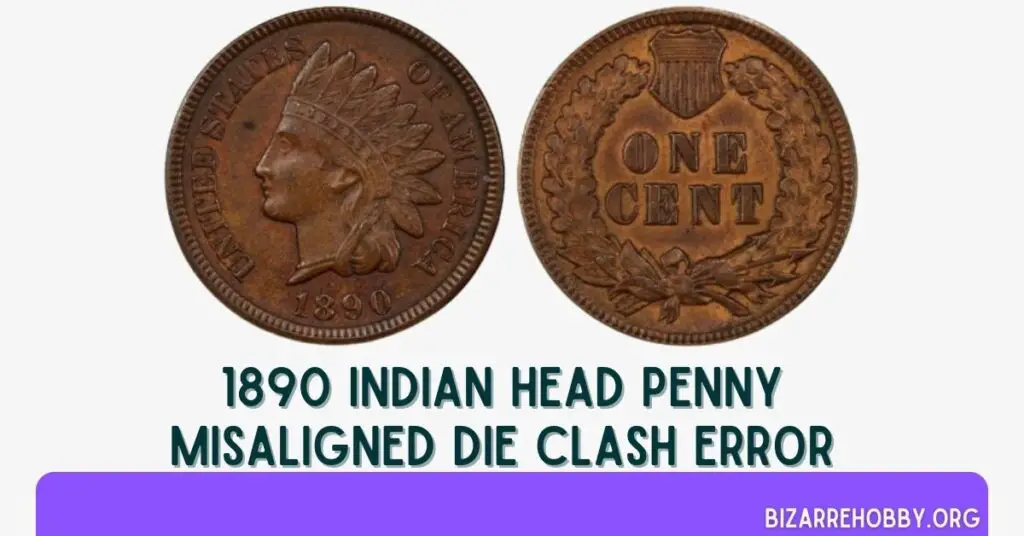The 1890 Indian Head Penny stands as a testament to one of America’s most beloved coin series. Second only to the Lincoln cent in popularity among small cents, these coins offer a unique blend of historical significance and collector appeal. Despite their age, many 1890 pennies remain accessible to collectors, thanks to high mintage numbers and careful preservation over the years.
Table of Contents
- Key Facts About the 1890 Indian Head Penny
- Value Chart for 1890 Indian Head Penny
- Historical Significance of the 1890 Indian Head Penny
- 1890 Indian Head Penny Types
- Design of the 1890 Indian Head Penny
- Grading Guide for 1890 Indian Head Penny
- 1890 Indian Head Penny Value Guide
- Rare 1890 Indian Head Penny Errors List
- Where to Sell Your 1890 Indian Head Penny?
- What to look out for in 1890 Indian Head Penny?
- Which 1890 Indian Head Penny is worth a lot of money?
- FAQs on 1890 Indian Head Penny Value
- Final Thoughts
Key Facts About the 1890 Indian Head Penny
- Mintage: 57,182,855 (Philadelphia Mint only)
- Designer: James Barton Longacre
- Composition: 95% copper, 5% tin and zinc
- Weight: 3.11 grams
- Diameter: 19 mm
Value Chart for 1890 Indian Head Penny
| Condition | 1890 No Mint mark penny |
|---|---|
| Good | $3 |
| Very Good | $3 |
| Fine | $5 |
| Very Fine | $7 |
| Extra Fine | $22 |
| AU | $38 |
| MS 60 | $80 |
| MS 63 | $115 |
| PR 63 | $300 |
Historical Significance of the 1890 Indian Head Penny

The story of the Indian Head Penny begins with the evolution of American coinage in the mid-19th century:
- 1793-1857: Large cents dominated, with seven design variations over 65 years.
- 1856: Rising copper prices prompted the introduction of smaller cents.
- 1856-1858: Flying Eagle cents bridged the gap between large cents and Indian Head pennies.
- 1859: First year of Indian Head penny production, featuring a laurel wreath reverse.
- 1860-1909: Indian Head pennies with oak wreath reverse design.
- 1890: The year of our focus, representing a mature stage in the series’ production.
The Indian Head Penny series marked a significant shift in American coinage. While some lamented the loss of the larger, more ornate cents, the new smaller format proved more practical for daily commerce. The design, featuring Liberty wearing a Native American headdress, became an iconic symbol of American coinage.
Mint Restrictions and the 1890 Issue
A little-known fact about Indian Head Pennies is the legal restriction on their production:
- By law, one-cent coins and five-cent nickels could only be minted in Philadelphia.
- This restriction lasted until 1908, making the 1890 issue exclusively a Philadelphia Mint product.
- No mint mark appears on 1890 Indian Head Pennies, consistent with Philadelphia’s practice at the time.
Understanding this context helps collectors appreciate why finding an 1890 Indian Head Penny from any other mint is impossible – a crucial fact for authenticating these coins.
The 1890 Indian Head Penny’s value varies significantly based on condition, with well-preserved specimens commanding premium prices. In the following sections, we’ll delve deeper into valuation, error varieties, and what makes this particular year special for collectors and numismatic enthusiasts alike.
1890 Indian Head Penny Types
| Location | Year | Minted |
|---|---|---|
| Philadelphia | 1890 No Mint Mark Penny | 57,180,114 |
| Philadelphia | 1890 Proof Penny | 2,740 |
| Total | NA | 57,182,854 |
Design of the 1890 Indian Head Penny
The 1890 Indian Head Penny showcases a design that has intrigued collectors for over a century. Created by James Barton Longacre, the coin’s aesthetics blend elements of Native American imagery with classical American symbolism, resulting in a unique and sometimes controversial representation.
While Longacre intended to depict a Native American woman, the result was distinctly European in appearance. This led to several theories:
- Sarah Longacre Theory: Many collectors believe the portrait was based on Longacre’s daughter, Sarah.
- Artistic Interpretation: Others argue it represents Longacre’s idealized vision of Liberty with Native American attributes.
- Cultural Misrepresentation: Modern critics point out the design’s problematic fusion of cultural elements.
Despite the debate, the coin retained its “Indian Head” moniker, becoming an iconic part of American numismatic history.
It’s worth noting that the 1890 issue differs slightly from the earliest Indian Head Pennies:
- 1859: Featured a laurel wreath on the reverse
- 1860-1909 (including 1890): Adopted the oak wreath design with a small shield at the top
This change in design reflects the coin’s evolution and provides a point of interest for collectors focusing on the series’ development.
Obverse Design of 1890 Indian Head Penny

The obverse of the 1890 Indian Head Penny features a profile that has sparked debate among numismatists:
- Central Figure: A young woman with Caucasian features wearing a Native American headdress
- Inscription: “UNITED STATES OF AMERICA” encircling the portrait
- Date: “1890” prominently displayed below the bust
- Headband Detail: The word “LIBERTY” inscribed on the figure’s headband
- Accessory: A pearl necklace, adding an unexpected touch of elegance
Reverse Design of 1890 Indian Head Penny

The reverse of the 1890 Indian Head Penny showcases a more straightforward yet equally symbolic design:
- Central Element: The denomination “ONE CENT” prominently displayed.
- Shield: A small shield above the denomination, representing national defense.
- Wreath: An oak wreath encircling the central elements, symbolizing strength and endurance.
- Composition: 95% copper, 5% tin and zinc, giving the coin its distinctive reddish-brown color.
- Edge: Plain, without reeding or inscriptions.
Technical Specifications of 1890 Indian Head Penny
| Face Value | One cent ($0.01) |
| Coin Diameter | 0.75 inches/19.05 mm |
| Shape | Round |
| Coin Weight | 0.10970 ounces/3.11 g |
| Compound | An alloy of 95% copper with zinc and tin |
| Coin Thickness | 0,058 inches/1.47 mm |
| Edge | Plain |
Grading Guide for 1890 Indian Head Penny
Grading is essential for determining an 1890 Indian Head Penny’s value. The Sheldon Scale, ranging from Poor (P-1) to Perfect Mint State (MS-70), is used to grade these coins. Here’s a simplified grading chart:
| Sheldon Scale | Grade |
|---|---|
| 1 | Basal State-1 |
| 2 | Fair |
| 3 | Very Fair |
| 4, 5, 6 | Good |
| 7, 8, 10 | Very Good |
| 12, 15 | Fine |
| 20, 30 | Very Fine |
| 40 | Extremely Fine |
| 50 | About Uncirculated |
| 60 | Mint State |
| 65 | Mint State |
| 70 | Mint State |
Even minor differences in grade can significantly impact value. When in doubt, consult a professional grading service like PCGS or NGC.
If you are looking for a dedicated Indian Head Penny Grading Guide, we’ve got you covered too.
1890 Indian Head Penny Value Guide
The 1890 Indian Head Penny, with a substantial mintage of 57,182,854 coins, offers collectors a range of options from common circulated pieces to rare, high-grade specimens. All 1890 pennies were minted in Philadelphia, including 57,180,114 for circulation and 2,740 proofs for collectors.
Factors Influencing 1890 Indian Head Penny Value
- Condition (Grade): Higher grades command premium prices
- Color: Red (RD) > Red-Brown (RB) > Brown (BN)
- Strike Quality: Well-struck coins are more desirable
- Rarity: Some varieties or errors can significantly increase value
1890 No Mint Mark Indian Head Penny Value (Circulation Strikes)

Brown (BN) Pennies
- MS-60 to MS-64: $42 to $345
- MS-65 to MS-66: $500 to $1,000
Record Sale: A GEM BU brown 1890 penny achieved $1,150 at Stack’s auction in 1999.
Red-Brown (RB) Pennies
- MS-60 to MS-64: $140 to $750
- MS-65 to MS-66: $1,000 to $2,250
Record Sale: An MS-66 RB specimen sold for an impressive $4,113 in 2014.
Red (RD) Pennies
- MS-63: $180 to $200
- MS-64: Approximately $550
- MS-65: Around $1,150
- MS-66: About $6,500
Record Sale: An exceptional MS-67+ red 1890 penny fetched a staggering $91,063 in 2020, setting the record for this issue.
1890 Proof Indian Head Penny Value

The Philadelphia Mint produced 2,740 proof coins in 1890, specially made for collectors. Their values vary by color:
Brown (BN) Proofs
- PR-60 to PR-66: $185 to $1,000
- PR-67: $1,700 to $2,000
Red-Brown (RB) Proofs
- PR-60 to PR-66: $200 to $2,000
- PR-67: $2,200 to $2,640
Red (RD) Proofs
- PR-60 to PR-66: $250 to $4,000
- Record Price: $5,040 for a PR-65 CAM (Cameo) quality coin (2019 auction)
Rare 1890 Indian Head Penny Errors List
While the 1890 Indian Head Penny set is relatively scarce in error coins, a few notable varieties exist. These imperfectly struck coins are highly sought after by collectors and can command significant premiums over standard issues.
Here’s a comprehensive look at the rare errors found in 1890 Indian Head Pennies.
1890 Indian Head Penny Double Strike Error
The most significant error in the 1890 Indian Head Penny series occurs when a coin is struck twice by the die, usually with the second strike slightly off-center. The main cause of this error is the failure to eject the coin between strikes.
Visual Characteristics
- Doubled design elements
- Often off-center appearance due to misalignment in second strike
Value Range
The value range for 1890 Indian Head Penny Double Strike Error is $500 to $2,000, depending on error visibility and coin condition.
1890 Indian Head Penny Tripled Die Obverse Error
This error results in a tripling of design elements on the obverse of the coin. Misalignment between the coin hub and die during the die creation process is the main cause of this error in 1890 Indian head pennies.
Visual Characteristics
- Tripled details in certain parts of the obverse design
- Most noticeable in fine details like lettering or date
Value Range
The value range of 1890 Indian Penny Triple die obverse error is $460 to $560 (based on recent auction records).
1890 Indian Head Penny Misplaced Date (MPD) Error
One or more digits of the date appear in an incorrect location on the coin. The main cause of this error in 1890 Indian head penny is improper placement of date digits on the die during its creation.
Visual Characteristics
- Extra digits or partial digits visible in unusual locations
- Often seen near the Indian’s neck or in the field
Record Sale: A red MS-64 grade MPD error sold for $700 in 2019.
1890 Indian Head Penny Misaligned Die Clash Error

The 1890 Indian head penny misaligned die clash error results from a significant misalignment of the hammer die with the anvil die. The main cause for this is improper setup of dies in the coining press.
Visual Characteristics
- Distorted or partial design elements
- Possible doubling or ghosting of design features
Notable Sale: An MS-63 brown example sold on eBay for $900 in 2019.
Where to Sell Your 1890 Indian Head Penny?
If you’ve determined that your 1890 Indian Head Penny is valuable and you’re ready to sell, there are several options available. Each has its pros and cons, so consider your priorities (speed, maximum value, convenience) when choosing.
- Coin Dealers
- Pros: Quick transactions, expertise in valuation
- Cons: May offer lower prices to ensure profit margin
- Best for: Those who want a quick, hassle-free sale
- Auction Houses
- Pros: Potential for high sale prices, especially for rare errors or high-grade coins
- Cons: Fees can be high, process can be lengthy
- Best for: Rare, high-value specimens
- Online Marketplaces (eBay, Etsy)
- Pros: Wide audience, potential for good prices
- Cons: Fees, potential for fraud, need to handle shipping
- Best for: Those comfortable with online transactions and willing to invest time
- Coin Shows
- Pros: Multiple potential buyers, opportunity to compare offers
- Cons: May need to travel, only periodic events
- Best for: Those who enjoy in-person transactions and negotiations
- Online Coin Forums
- Pros: Community of enthusiasts, potential for fair prices
- Cons: Need to establish reputation, potential for scams
- Best for: Those engaged in the coin collecting community
- Local Coin Clubs
- Pros: Build relationships, learn from experienced collectors
- Cons: Limited pool of potential buyers
- Best for: Those looking to connect with fellow enthusiasts
Remember, regardless of where you choose to sell your coin, it’s crucial to have a good understanding of your coin’s value. Consider getting your 1890 Indian Head Penny professionally graded, especially if you suspect it’s a high-grade specimen or rare error variety.
What to look out for in 1890 Indian Head Penny?
When examining an 1890 Indian Head Penny:
- Look for the clear “LIBERTY” inscription on the headband,
- Check for the oak wreath design, distinguishing it from the 1859 issue,
- Note the absence of a mint mark, confirming Philadelphia Mint production,
- Assess the coin’s color, which can range from brown to red depending on preservation.
Understanding these features not only aids in authentication and its value but also deepens appreciation for the artistry and historical context of the 1890 Indian Head Penny.
Which 1890 Indian Head Penny is worth a lot of money?
- 1890 MS 67+ Red: $91,063 (2020)
- 1890 PR 65 CAM: $5,040 (2019)
- 1890 MS 66 Red-Brown: $4,113 (2014)
- 1890 PR 65 Red: $2,875 (2001)
- 1890 PR 66 RB: $2,000 (2021)
- 1890 GEM BU Brown: $1,150 (1999)
- 1890 MS 63 Brown (Misaligned Die Clash): $900 (2019)
- 1890 PR 64+ Brown: $800 (2022)
- 1890 MS 64 Red-Brown (MPD error): $700 (2019)
- 1890 AU 58 Brown CAC (TDO error): $558 (2013)
- 1890 MS 63 Red-Brown (TDO error): $518 (2011)
- 1890 MS 63 TDO RD (TDO error): $460 (2011)
- 1890 UNC Details: $78 (2023)
FAQs on 1890 Indian Head Penny Value
What makes an 1890 Indian Head penny rare?
The 1890 Indian Head pennies are over 130 years old, making them rarer than modern coins. While lower-grade coins are relatively easy to find, high-grade ones are scarce and more expensive.
How much is the 1890 No Mint mark Indian Head penny worth?
Brown pennies range from $1 to $40 in circulated condition and $42 to $937.50 in perfect condition. Red-brown pennies are valued at $140 to $1,750, while red pennies range from $180 to $4,500, with a record price of $91,063 in 2020.
What is the most pricey Indian Head penny?
The most expensive is an 1864 error coin with an “L On Ribbon” in PR 65 grade, sold for $161,000 in 2011. The priciest regular strike is the 1877 MS 66, sold for $149,500 in 2007. The most valuable proof is the 1897 PR 67+ deep cameo, sold for $108,000 in 2021. The 1909 MS 67 from the San Francisco mint sold for $97,750 in 2006.
Final Thoughts
As we’ve explored throughout this guide, the 1890 Indian Head Penny holds a special place in American numismatics. Despite its age of over 130 years, this coin continues to captivate collectors and investors alike.
Ultimately, whether you’re buying, selling, or simply appreciating these historic coins, the 1890 Indian Head Penny continues to demonstrate why numismatics is such a rewarding pursuit. It combines history, art, economics, and the eternal human fascination with the treasures of the past.
